Coconut Oil Market
Coconut Oil Market Size and Share Forecast Outlook 2025 to 2035
The coconut oil market is projected to grow from USD 7.8 billion in 2025 to USD 11.1 billion by 2035, at a CAGR of 3.6%. Refined (RBD) will dominate with a 63.0% market share, while food will lead the application segment with a 41.0% share.
Coconut Oil Market Forecast and Outlook 2025 to 2035
The global coconut oil market is projected to reach USD 11.1 billion by 2035, recording an absolute increase of USD 3.3 billion over the forecast period. The market is valued at USD 7.8 billion in 2025 and is set to rise at a CAGR of 3.6% during the assessment period.
The market is expected to grow by nearly 1.4 times during the same period, supported by increasing consumer awareness of natural and healthy cooking oils worldwide, driving demand for virgin coconut oil and specialty applications, and growing adoption in personal care and industrial sectors globally. However, price volatility due to climate conditions affecting tropical coconut production and competition from alternative plant oils may pose challenges to market expansion.
Quick Stats for Coconut Oil Market
- Coconut Oil Market Value (2025): USD 7.8 billion
- Coconut Oil Market Forecast Value (2035): USD 11.1 billion
- Coconut Oil Market Forecast CAGR: 3.6%
- Leading Type in Coconut Oil Market: Refined (RBD) Coconut Oil
- Key Growth Regions in Coconut Oil Market: Asia-Pacific, North America, and Europe
- Top Key Players in Coconut Oil Market: Wilmar, Olam, Cargill, ADM, Franklin Baker, Celebes, Peter Paul, Ciif Oils, VVF, Marico (Parachute)
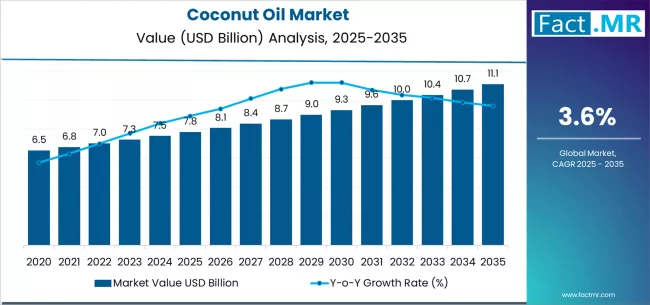
Between 2025 and 2030, the coconut oil market is projected to expand from USD 7.8 billion to USD 9.3 billion, resulting in a value increase of USD 1.5 billion, which represents 45.5% of the total forecast growth for the decade.
This phase of development will be shaped by rising health consciousness and natural product preferences, product innovation in MCT oils and virgin coconut oil formulations, as well as expanding integration with functional food applications and premium personal care products.
Companies are establishing competitive positions through investment in sustainable sourcing partnerships, traceability programs, and strategic market expansion across food, personal care, and industrial applications.
From 2030 to 2035, the market is forecast to grow from USD 9.3 billion to USD 11.1 billion, adding another USD 1.8 billion, which constitutes 54.5% of the overall ten-year expansion. This period is expected to be characterized by the expansion of specialty coconut oil products, including organic and fair-trade certified oils and premium MCT formulations tailored for nutrition and cosmetic applications, strategic collaborations between tropical producers and international food companies, and an enhanced focus on sustainability and ethical sourcing practices. The growing emphasis on natural wellness and clean label products will drive demand for comprehensive coconut oil solutions across diverse food, beauty, and industrial applications.
Coconut Oil Market Key Takeaways
| Metric | Value |
|---|---|
| Market Value (2025) | USD 7.8 billion |
| Market Forecast Value (2035) | USD 11.1 billion |
| Forecast CAGR (2025-2035) | 3.6% |
Why is the Coconut Oil Market Growing?
The coconut oil market grows by enabling food manufacturers, personal care companies, and health-conscious consumers to access versatile natural oils and functional ingredients that deliver superior nutritional and cosmetic benefits without artificial additives or chemical processing.
Health-conscious consumers and natural product manufacturers face increasing demand for clean-label ingredients and multi-functional oils, with coconut oil typically providing medium-chain triglycerides (MCTs), antimicrobial properties, and natural preservation benefits that synthetic alternatives cannot replicate, making authentic coconut oil essential for natural wellness and clean beauty positioning.
The food and personal care industries' need for versatile natural ingredients creates demand for comprehensive coconut oil solutions that can provide functional benefits, maintain natural authenticity, and ensure consistent quality without compromising performance or regulatory compliance.
Government initiatives promoting tropical agriculture and sustainable farming practices drive adoption in producing countries and international markets, where coconut cultivation has a direct impact on rural economic development and environmental sustainability.
Climate variability affecting tropical regions and supply chain complexities may constrain consistent availability among growing global demand for natural oils and specialty coconut products in developed markets.
Segmental Analysis
The market is segmented by type, application, and region. By type, the market is divided into refined (RBD), virgin, fractionated/MCT, and others. Based on application, the market is categorized into food, personal care, industrial/others. Regionally, the market is divided into Asia-Pacific, North America, Europe, and other key regions.
By Type, the Refined (RBD) Segment Accounts for a Dominant Market Share
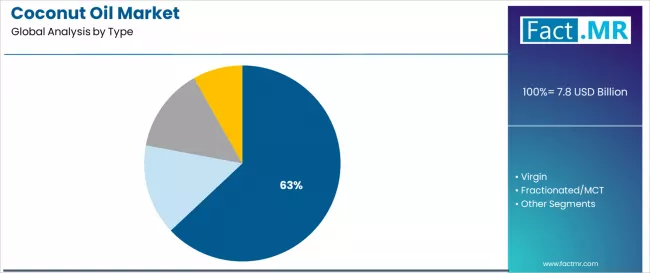
The refined (RBD) coconut oil segment represents the dominant force in the coconut oil market, capturing approximately 63.0% of total market share in 2025. This type category encompasses commercially processed coconut oil featuring standardized quality characteristics, extended shelf life, and neutral flavor profiles that enable superior food manufacturing applications and industrial processing requirements.
The refined (RBD) segment's market leadership stems from its superior functionality capabilities, with products capable of serving diverse commercial applications while maintaining consistent quality standards and cost-effectiveness across all major food and industrial markets.
The virgin coconut oil segment maintains a substantial 27.0% market share, serving health-conscious consumers and premium personal care manufacturers who require unprocessed coconut oil with enhanced nutritional properties and natural coconut aroma for wellness and beauty applications.
These products offer premium natural experiences for discerning consumers while providing sufficient therapeutic and cosmetic benefits to meet health-focused and natural beauty positioning demands.
The fractionated/MCT segment accounts for approximately 10.0% of the market, serving specialized nutrition and cosmetic applications requiring concentrated medium-chain triglycerides and specialized processing characteristics.
Key processing advantages driving the refined (RBD) segment include:
- Standardized processing methods with consistent quality profiles that ensure reliable food manufacturing performance and industrial application compatibility
- Extended shelf stability enabling long-term storage and transportation without quality degradation or rancidity concerns
- Neutral flavor characteristics allowing versatile food applications without altering product taste profiles or consumer acceptance
- Enhanced cost-effectiveness features, providing competitive pricing for large-scale commercial applications and industrial processing requirements
By Application, the Food Segment Accounts for the Largest Market Share
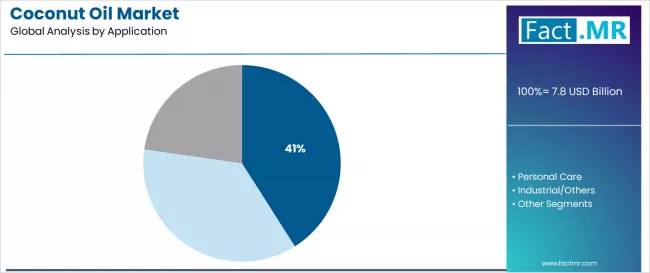
Food applications dominate the coconut oil market with approximately 41.0% market share in 2025, reflecting the established use of coconut oil in cooking, food manufacturing, and culinary applications across traditional coconut-consuming regions and health-conscious international markets worldwide.
The food segment's market leadership is reinforced by coconut oil's functional properties in baking, frying, and food processing, creating strong consumer preference and commercial adoption across developed and emerging food markets.
The personal care segment represents the second-largest application category, capturing 37.0% market share through cosmetic formulations, hair care products, and skincare applications that leverage coconut oil's moisturizing properties and natural preservation benefits.
This segment benefits from growing demand for natural beauty ingredients that meet specific skin and hair care requirements, clean beauty standards, and premium personal care positioning in competitive cosmetic markets.
The industrial/others segment accounts for 22.0% market share, serving industrial applications through oleochemical production, biodiesel manufacturing, and specialized industrial processing uses. This segment demonstrates growth through enhanced sustainability positioning, renewable energy applications, and industrial biotechnology development.
Key market dynamics supporting application growth include:
- Food market expansion driven by health-conscious cooking trends and natural food manufacturing ingredient preferences
- Personal care modernization requiring premium natural moisturizing ingredients for clean beauty and organic cosmetic applications
- Industrial development enabling sustainable oleochemical production and renewable energy applications
- Growing emphasis on multi-functional natural ingredients driving demand for versatile coconut oil solutions across food, beauty, and industrial sectors
What are the Drivers, Restraints, and Key Trends of the Coconut Oil Market?
Increasing awareness of healthy cooking oils and natural nutrition create expanding demand for virgin coconut oil and MCT products, with health-focused food consumption growing by 6-8% annually in major developed countries worldwide, requiring comprehensive natural oil sourcing infrastructure.
Clean beauty trends and natural personal care preferences drive increased adoption of coconut oil in cosmetic applications, with many beauty brands prioritizing natural moisturizing ingredients and sustainable formulations by 2030.
Technological improvements in processing methods and specialty product development enable more effective and targeted coconut oil products that deliver superior functional benefits while maintaining natural characteristics and therapeutic properties.
Market restraints include price volatility due to climate conditions affecting coconut production in key tropical regions, potentially causing supply shortages and cost fluctuations during challenging weather seasons.
Competition from alternative plant oils poses another significant challenge, as palm oil, sunflower oil, and other vegetable oils often provide cost advantages and similar functional properties, potentially limiting coconut oil adoption among price-sensitive applications.
Supply chain complexities in tropical producing regions create additional operational challenges across different market segments, demanding ongoing investment in logistics infrastructure and quality preservation systems.
Key trends indicate accelerated growth in MCT oils and specialty coconut products, particularly in North America and Europe, where functional nutrition and premium wellness applications drive comprehensive specialty product adoption.
Technology integration trends toward traceability systems with sustainability certification, organic processing methods, and direct producer partnerships enable enhanced quality assurance that meets evolving consumer transparency expectations and ethical sourcing requirements.
However, the market thesis could face disruption if alternative plant oils achieve superior functionality or significant environmental challenges affect traditional tropical coconut cultivation regions.
Analysis of the Coconut Oil Market by Key Country
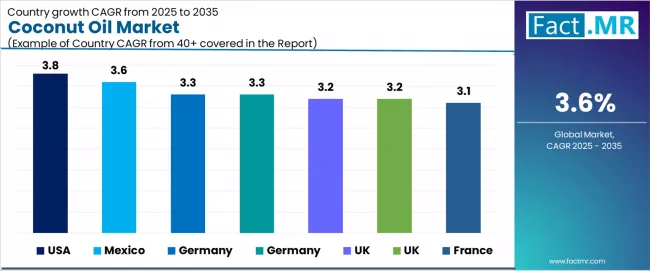
| Country | CAGR (2025-2035) |
|---|---|
| USA | 3.8% |
| Mexico | 3.6% |
| Germany | 3.3% |
| South Korea | 3.3% |
| UK | 3.2% |
| Japan | 3.2% |
| France | 3.1% |
The coconut oil market is gaining momentum worldwide, with the USA taking the lead thanks to strong health and wellness trends and established natural food products market infrastructure. Close behind, Mexico benefits from traditional cooking culture and growing health-conscious consumer segments, positioning itself as a strategic growth hub in the Latin American region. Germany and South Korea show equal advancement, where integration of natural nutrition trends strengthens their roles in the European and Asian healthy food supply chains.
The UK and Japan demonstrate steady growth momentum, focusing on premium natural products and health-conscious lifestyle applications, signaling ambitions to capitalize on the growing opportunities in wellness-focused consumer markets. Meanwhile, France continues to record consistent progress in natural food ingredients and premium personal care applications. Together, the USA and Mexico anchor the global expansion story, while the rest build stability and diversity into the market's growth path.
The report covers an in-depth analysis of 40+ countries; 7 top-performing countries are highlighted below.
USA Leads Global Market Expansion
The USA demonstrates the strongest growth potential in the Coconut Oil Market with a CAGR of 3.8% through 2035. The country's leadership position stems from robust health and wellness culture, established natural products market, and strong consumer awareness of coconut oil benefits driving the adoption of premium virgin coconut oil and specialized MCT products.
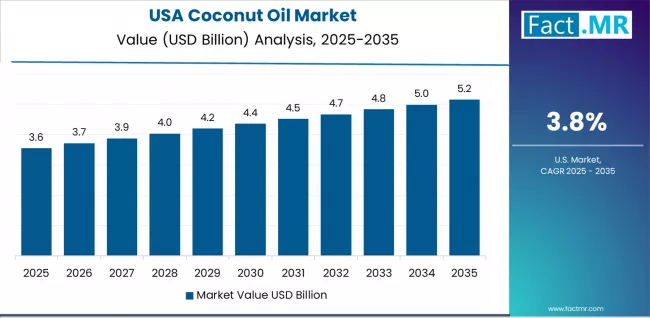
Growth is concentrated in major metropolitan areas, including New York, Los Angeles, Chicago, and Miami, where health-conscious consumers and natural food enthusiasts are implementing comprehensive coconut oil usage across cooking, personal care, and wellness applications for enhanced lifestyle benefits.
Distribution channels through natural food retailers and health-focused grocery chains expand coverage across wellness-oriented markets and health-conscious demographics throughout the country. The country's emphasis on clean eating and natural wellness provides sustained demand for coconut oil innovation, including organic certifications and specialty formulations.
Key market factors:
- Health and wellness expansion concentrated in metropolitan areas and affluent markets with comprehensive natural food retail infrastructure development programs
- Consumer health consciousness through established clean eating culture and natural nutrition adoption patterns
- Comprehensive natural products ecosystem, including established health food stores and wellness-focused retailers
- Innovation leadership featuring MCT oil development, organic processing initiatives, and premium coconut oil application capabilities
Mexico Emerges as High-Growth Market
In Mexico City, Guadalajara, Monterrey, and coastal regions, the adoption of comprehensive coconut oil products is accelerating across traditional cooking applications and expanding health-conscious consumer segments, driven by cultural familiarity with tropical oils and increasing wellness awareness.
The market demonstrates strong growth momentum with a CAGR of 3.6% through 2035, linked to comprehensive economic development and increasing focus on natural food ingredients and traditional cooking enhancement.
Mexican consumers are implementing coconut oil in traditional recipes and modern health applications to improve nutrition quality while maintaining cultural food preferences in expanding urban and traditional markets.
The country's tropical climate familiarity and cultural openness to natural ingredients create sustained demand for coconut oil products, while increasing emphasis on health and wellness drives adoption of premium and virgin coconut oil varieties.
- Leading traditional and urban markets, including Mexico City, Guadalajara, and coastal areas, are driving coconut oil product adoption
- Cultural advantage models enabling traditional cooking integration and health-conscious lifestyle enhancement
- Consumer familiarity trends accelerating adoption with established tropical oil usage patterns and wellness education
- Economic advantages through regional trade relationships and cultural acceptance of tropical agricultural products
Germany Maintains Natural Food Leadership
Germany's established natural food and organic products sector demonstrate sophisticated implementation of coconut oil products, with documented case studies showing 20% increase in natural cooking oil adoption through health food retailers and organic food chains.
The country's natural products infrastructure in major cities, including Berlin, Munich, Hamburg, and Frankfurt, showcases integration of traditional European cooking with modern health-conscious ingredients, leveraging expertise in organic food retail and sustainable sourcing.
German consumers emphasize quality and environmental sustainability, creating demand for certified organic coconut oil products that support healthy cooking goals and environmental responsibility. The market maintains steady growth through focus on organic food innovation and sustainability standards, with a CAGR of 3.3% through 2035.
Key development areas:
- Health food retailers and organic food chains leading natural coconut oil adoption with comprehensive sustainability programs
- Quality certification channels providing integrated solutions with 95% organic compliance rates
- Sustainability partnerships between German food companies and tropical coconut producers expanding ethical market reach
- Integration of traditional European cooking and modern natural ingredient sustainability standards
Europe Market Split by Country
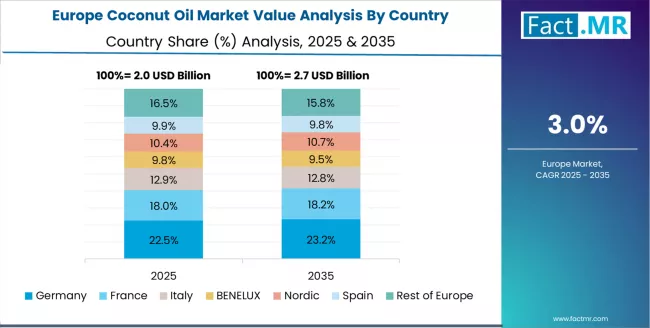
The coconut oil market in Europe is projected to grow from USD 1.56 billion in 2025 to USD 2.22 billion by 2035, registering a CAGR of 3.6% over the forecast period. Germany is expected to maintain its leadership position with a 26.9% market share in 2025, declining slightly to 26.7% by 2035, supported by its strong organic food retail infrastructure, established health-conscious consumer culture, and comprehensive natural product distribution networks serving major European markets.
The United Kingdom follows with a 24.4% share in 2025, projected to reach 24.5% by 2035, driven by comprehensive natural food modernization programs in London, Manchester, and other metropolitan areas implementing advanced health food retail experiences.
France holds a 19.9% share in 2025, expected to maintain 19.7% by 2035 through the ongoing development of premium cooking ingredients and natural personal care applications. Italy commands a 15.4% share, while Spain accounts for 10.3% in 2025.
Rest of Europe is anticipated to gain momentum, expanding its collective share from 3.1% to 3.4% by 2035, attributed to increasing coconut oil adoption in Nordic countries and emerging Eastern European health food markets implementing natural nutrition standards.
Competitive Landscape of the Coconut Oil Market
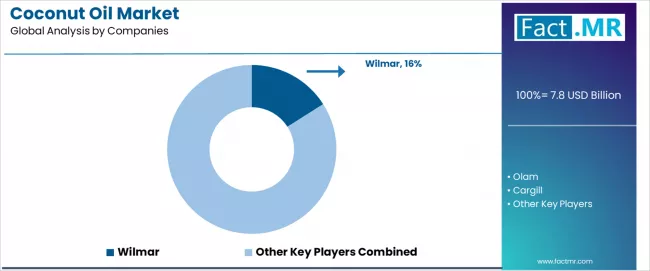
The coconut oil market features approximately 35-45 meaningful players with moderate concentration, where the top three companies control roughly 18-24% of global market share through established tropical sourcing relationships and extensive food industry partnerships. Competition centers on quality consistency, sustainable sourcing, and processing capabilities rather than price competition alone.
Market leaders include Wilmar, Olam, and Cargill, which maintain competitive advantages through comprehensive coconut oil sourcing portfolios, direct producer relationships, and deep expertise in tropical oil processing and global food supply chain management, creating strong industry partnerships and quality assurance capabilities. These companies leverage established Philippines and Indonesian sourcing networks and ongoing sustainability investments to defend market positions while expanding into adjacent tropical oil categories and specialty product segments.
Challengers encompass ADM and Franklin Baker, which compete through specialized food applications and strong presence in key consumer markets. Food processing and personal care specialists, including Celebes, Peter Paul, and Ciif Oils, focus on specific applications or regional markets, offering differentiated capabilities in virgin coconut oil production, specialty processing, and premium product positioning.
Regional players and producer cooperatives create competitive pressure through direct sourcing capabilities and authentic positioning, particularly in high-growth markets including North America and Europe, where organic certification provides advantages in health food positioning and sustainability verification.
Market dynamics favor companies that combine authentic tropical sourcing with comprehensive quality certification and established food industry relationships that address the complete coconut oil supply chain from plantation cultivation through consumer food and personal care applications.
Global Coconut Oil Market - Stakeholder Contribution Framework
Coconut oil solutions represent a critical natural ingredient that enables food manufacturers, personal care companies, and health-conscious consumers to access versatile tropical oils and functional ingredients without synthetic additives or chemical processing, typically providing superior nutritional benefits, moisturizing properties, and natural preservation capabilities compared to synthetic alternatives.
With the market projected to grow from USD 7.8 billion in 2025 to USD 11.1 billion by 2035 at a 3.6% CAGR, these solutions offer compelling advantages - natural versatility, functional benefits, and sustainable sourcing - making them essential for food applications (41.0% market share), personal care products (37.0% share), and diverse industrial formulations seeking reliable natural ingredient solutions.
Scaling market penetration and sustainability practices requires coordinated action across tropical agriculture policy, sustainable farming standards, coconut oil processors, food and personal care industry partners, and tropical agricultural organizations.
How Governments Could Spur Local Production and Adoption?
- Tropical Agriculture Programs: Include coconut cultivation in national agricultural development initiatives, providing targeted support for Philippines and Indonesian farming communities and supporting sustainable plantation methods through development financing and processing infrastructure grants.
- Trade Policy & Sustainability Support: Implement favorable treatment for certified sustainable imports, provide incentives for companies investing in fair-trade sourcing and organic processing, and establish quality standards that encourage natural ingredient adoption over synthetic alternatives.
- Regulatory Framework Development: Create standardized quality verification processes across food and personal care applications, establish clear organic certification frameworks for international trade, and develop traceability protocols that facilitate authentic coconut oil commerce.
- Agricultural Development & Training: Fund sustainable farming programs for tropical producers, integrated plantation management education, and processing technology improvements. Invest in agricultural extension services that bridge traditional cultivation with modern quality standards and international market requirements.
- Market Access & Rural Development: Establish procurement policies that support sustainable tropical agriculture for government applications, assist farming cooperatives through preferential trade programs, and create regulatory environments that encourage innovation in sustainable coconut processing and value-added products.
How Industry Bodies Could Support Market Development?
- Quality Standards & Certification: Define standardized quality metrics for coconut oil across food and personal care applications, establish universal purity and sustainability protocols, and create certification programs for sustainable sourcing practices that consumers and businesses can trust.
- Market Education & Best Practices: Lead messaging that demonstrates coconut oil advantages, emphasizing natural functionality, health benefits, and sustainable sourcing compared to synthetic and alternative oil products.
- Sustainability Integration Standards: Develop interoperability standards for organic certification, sustainable plantation guidelines, and fair-trade partnership platforms, ensuring seamless integration across different food and personal care applications and international markets.
- Professional Development: Run certification programs for food technologists, cosmetic formulators, and sourcing specialists on optimizing coconut oil applications, quality verification, and sustainable sourcing practices in competitive natural products markets.
How Manufacturers and Technology Players Could Strengthen the Ecosystem?
- Advanced Processing Development: Develop next-generation extraction and refining methods with enhanced quality consistency capabilities, improved nutritional preservation, and sustainable processing features that maintain natural benefits while enabling superior product performance and shelf stability.
- Innovation Platforms: Provide comprehensive traceability systems that integrate blockchain verification, producer partnerships, sustainability monitoring, and quality assurance, enabling food and personal care brands to maximize sourcing transparency and consumer confidence.
- Service & Support Networks: Offer flexible support programs for food and personal care companies, including analytical testing options, technical consultation services, and sustainability guidance that keep coconut oil products current with market demands and regulatory requirements.
- Research & Development Networks: Build comprehensive R&D capabilities, collaborative sustainability programs, and application development systems that ensure coconut oil technologies maintain superior functionality and consistent quality across diverse food, personal care, and industrial applications.
How Suppliers Could Navigate the Shift?
- Diversified Application Portfolios: Expand coconut oil offerings across food (41.0% market dominance), personal care (37.0% share), and industrial applications, with particular focus on refined (RBD) products (63.0% type share) and sustainable sourcing strategies.
- Geographic Market Development: Establish operations in high-growth markets like USA (3.8% CAGR) and Mexico (3.6% CAGR), while strengthening presence in established markets like Germany (3.3% CAGR) and South Korea (3.3% CAGR) through regional processing capabilities and direct producer relationships.
- Technology-Enabled Services: Implement advanced traceability systems with quality verification, sustainability reporting, and functionality testing capabilities that differentiate service offerings and improve food and personal care industry partnership satisfaction.
- Flexible Processing Models: Develop refined, virgin, and specialty coconut oil solutions that accommodate varying industry needs, from cost-effective food manufacturing to premium personal care products for demanding natural beauty requirements.
How Investors and Financial Enablers Could Unlock Value?
- Supply Chain Expansion Financing: Provide growth capital for established companies like Wilmar, Olam, and Cargill to expand tropical sourcing capabilities and processing capacity, particularly in Philippines and Indonesia with growing natural products demands.
- Innovation Investment: Back startups developing advanced processing technologies, sustainability certification platforms, and specialty product development systems that enhance coconut oil industry innovation and competitive positioning.
- Regional Market Development: Finance market entry and expansion strategies for coconut oil companies establishing operations in high-growth regions, supporting producer partnerships that enhance sustainable sourcing while maintaining traditional cultivation methods.
- Consolidation & Scale Opportunities: Support strategic acquisitions and supply chain consolidation that create economies of scale, improve sustainability capabilities, and enhance competitive positioning against fragmented regional tropical oil providers across multiple geographic markets.
Key Players in the Coconut Oil Market
- Wilmar
- Olam
- Cargill
- ADM
- Franklin Baker
- Celebes
- Peter Paul
- Ciif Oils
- VVF
- Marico (Parachute)
Scope of the Report
| Item | Value |
|---|---|
| Quantitative Units | USD 7.8 Billion |
| Type | Refined (RBD), Virgin, Fractionated/MCT, Others |
| Application | Food, Personal Care, Industrial/Others |
| Regions Covered | Asia-Pacific, North America, Europe, Latin America, Middle East & Africa |
| Country Covered | USA, Mexico, Germany, South Korea, UK, Japan, France, and 40+ countries |
| Key Companies Profiled | Wilmar, Olam, Cargill, ADM, Franklin Baker, Celebes, Peter Paul, Ciif Oils, VVF, Marico (Parachute) |
| Additional Attributes | Dollar sales by type and application categories, regional adoption trends across Asia-Pacific, North America, and Europe, competitive landscape with tropical oil suppliers and food industry partners, sustainable sourcing patterns and producer relationships, integration with health and wellness trends and organic certification programs, innovations in processing technology and specialty product development, and development of specialized applications with quality verification and natural positioning. |
Coconut Oil Market by Segments
-
Type:
- Refined (RBD)
- Virgin
- Fractionated/MCT
- Others
-
Application:
- Food
- Personal Care
- Industrial/Others
-
Region:
- Asia-Pacific
- China
- Japan
- South Korea
- India
- Australia & New Zealand
- ASEAN
- Rest of Asia Pacific
- North America
- United States
- Canada
- Mexico
- Europe
- Germany
- United Kingdom
- France
- Italy
- Spain
- Nordic
- BENELUX
- Rest of Europe
- Latin America
- Brazil
- Chile
- Rest of Latin America
- Middle East & Africa
- Kingdom of Saudi Arabia
- Other GCC Countries
- Turkey
- South Africa
- Other African Union
- Rest of Middle East & Africa
- Asia-Pacific
Table of Content
- Executive Summary
- Global Market Outlook
- Demand to side Trends
- Supply to side Trends
- Technology Roadmap Analysis
- Analysis and Recommendations
- Market Overview
- Market Coverage / Taxonomy
- Market Definition / Scope / Limitations
- Market Background
- Market Dynamics
- Drivers
- Restraints
- Opportunity
- Trends
- Scenario Forecast
- Demand in Optimistic Scenario
- Demand in Likely Scenario
- Demand in Conservative Scenario
- Opportunity Map Analysis
- Product Life Cycle Analysis
- Supply Chain Analysis
- Investment Feasibility Matrix
- Value Chain Analysis
- PESTLE and Porter’s Analysis
- Regulatory Landscape
- Regional Parent Market Outlook
- Production and Consumption Statistics
- Import and Export Statistics
- Market Dynamics
- Global Market Analysis 2020 to 2024 and Forecast, 2025 to 2035
- Historical Market Size Value (USD Million) Analysis, 2020 to 2024
- Current and Future Market Size Value (USD Million) Projections, 2025 to 2035
- Y to o to Y Growth Trend Analysis
- Absolute $ Opportunity Analysis
- Global Market Pricing Analysis 2020 to 2024 and Forecast 2025 to 2035
- Global Market Analysis 2020 to 2024 and Forecast 2025 to 2035, By Type
- Introduction / Key Findings
- Historical Market Size Value (USD Million) Analysis By Type , 2020 to 2024
- Current and Future Market Size Value (USD Million) Analysis and Forecast By Type , 2025 to 2035
- Refined (RBD)
- Virgin
- Fractionated/MCT
- Others
- Y to o to Y Growth Trend Analysis By Type , 2020 to 2024
- Absolute $ Opportunity Analysis By Type , 2025 to 2035
- Global Market Analysis 2020 to 2024 and Forecast 2025 to 2035, By Application
- Introduction / Key Findings
- Historical Market Size Value (USD Million) Analysis By Application, 2020 to 2024
- Current and Future Market Size Value (USD Million) Analysis and Forecast By Application, 2025 to 2035
- Food
- Personal Care
- Industrial/Others
- Y to o to Y Growth Trend Analysis By Application, 2020 to 2024
- Absolute $ Opportunity Analysis By Application, 2025 to 2035
- Global Market Analysis 2020 to 2024 and Forecast 2025 to 2035, By Region
- Introduction
- Historical Market Size Value (USD Million) Analysis By Region, 2020 to 2024
- Current Market Size Value (USD Million) Analysis and Forecast By Region, 2025 to 2035
- North America
- Latin America
- Western Europe
- Eastern Europe
- East Asia
- South Asia and Pacific
- Middle East & Africa
- Market Attractiveness Analysis By Region
- North America Market Analysis 2020 to 2024 and Forecast 2025 to 2035, By Country
- Historical Market Size Value (USD Million) Trend Analysis By Market Taxonomy, 2020 to 2024
- Market Size Value (USD Million) Forecast By Market Taxonomy, 2025 to 2035
- By Country
- USA
- Canada
- Mexico
- By Type
- By Application
- By Country
- Market Attractiveness Analysis
- By Country
- By Type
- By Application
- Key Takeaways
- Latin America Market Analysis 2020 to 2024 and Forecast 2025 to 2035, By Country
- Historical Market Size Value (USD Million) Trend Analysis By Market Taxonomy, 2020 to 2024
- Market Size Value (USD Million) Forecast By Market Taxonomy, 2025 to 2035
- By Country
- Brazil
- Chile
- Rest of Latin America
- By Type
- By Application
- By Country
- Market Attractiveness Analysis
- By Country
- By Type
- By Application
- Key Takeaways
- Western Europe Market Analysis 2020 to 2024 and Forecast 2025 to 2035, By Country
- Historical Market Size Value (USD Million) Trend Analysis By Market Taxonomy, 2020 to 2024
- Market Size Value (USD Million) Forecast By Market Taxonomy, 2025 to 2035
- By Country
- Germany
- UK
- Italy
- Spain
- France
- Nordic
- BENELUX
- Rest of Western Europe
- By Type
- By Application
- By Country
- Market Attractiveness Analysis
- By Country
- By Type
- By Application
- Key Takeaways
- Eastern Europe Market Analysis 2020 to 2024 and Forecast 2025 to 2035, By Country
- Historical Market Size Value (USD Million) Trend Analysis By Market Taxonomy, 2020 to 2024
- Market Size Value (USD Million) Forecast By Market Taxonomy, 2025 to 2035
- By Country
- Russia
- Poland
- Hungary
- Balkan & Baltic
- Rest of Eastern Europe
- By Type
- By Application
- By Country
- Market Attractiveness Analysis
- By Country
- By Type
- By Application
- Key Takeaways
- East Asia Market Analysis 2020 to 2024 and Forecast 2025 to 2035, By Country
- Historical Market Size Value (USD Million) Trend Analysis By Market Taxonomy, 2020 to 2024
- Market Size Value (USD Million) Forecast By Market Taxonomy, 2025 to 2035
- By Country
- China
- Japan
- South Korea
- By Type
- By Application
- By Country
- Market Attractiveness Analysis
- By Country
- By Type
- By Application
- Key Takeaways
- South Asia and Pacific Market Analysis 2020 to 2024 and Forecast 2025 to 2035, By Country
- Historical Market Size Value (USD Million) Trend Analysis By Market Taxonomy, 2020 to 2024
- Market Size Value (USD Million) Forecast By Market Taxonomy, 2025 to 2035
- By Country
- India
- ASEAN
- Australia & New Zealand
- Rest of South Asia and Pacific
- By Type
- By Application
- By Country
- Market Attractiveness Analysis
- By Country
- By Type
- By Application
- Key Takeaways
- Middle East & Africa Market Analysis 2020 to 2024 and Forecast 2025 to 2035, By Country
- Historical Market Size Value (USD Million) Trend Analysis By Market Taxonomy, 2020 to 2024
- Market Size Value (USD Million) Forecast By Market Taxonomy, 2025 to 2035
- By Country
- Kingdom of Saudi Arabia
- Other GCC Countries
- Turkiye
- South Africa
- Other African Union
- Rest of Middle East & Africa
- By Type
- By Application
- By Country
- Market Attractiveness Analysis
- By Country
- By Type
- By Application
- Key Takeaways
- Key Countries Market Analysis
- USA
- Pricing Analysis
- Market Share Analysis, 2024
- By Type
- By Application
- Canada
- Pricing Analysis
- Market Share Analysis, 2024
- By Type
- By Application
- Mexico
- Pricing Analysis
- Market Share Analysis, 2024
- By Type
- By Application
- Brazil
- Pricing Analysis
- Market Share Analysis, 2024
- By Type
- By Application
- Chile
- Pricing Analysis
- Market Share Analysis, 2024
- By Type
- By Application
- Germany
- Pricing Analysis
- Market Share Analysis, 2024
- By Type
- By Application
- UK
- Pricing Analysis
- Market Share Analysis, 2024
- By Type
- By Application
- Italy
- Pricing Analysis
- Market Share Analysis, 2024
- By Type
- By Application
- Spain
- Pricing Analysis
- Market Share Analysis, 2024
- By Type
- By Application
- France
- Pricing Analysis
- Market Share Analysis, 2024
- By Type
- By Application
- India
- Pricing Analysis
- Market Share Analysis, 2024
- By Type
- By Application
- ASEAN
- Pricing Analysis
- Market Share Analysis, 2024
- By Type
- By Application
- Australia & New Zealand
- Pricing Analysis
- Market Share Analysis, 2024
- By Type
- By Application
- China
- Pricing Analysis
- Market Share Analysis, 2024
- By Type
- By Application
- Japan
- Pricing Analysis
- Market Share Analysis, 2024
- By Type
- By Application
- South Korea
- Pricing Analysis
- Market Share Analysis, 2024
- By Type
- By Application
- Russia
- Pricing Analysis
- Market Share Analysis, 2024
- By Type
- By Application
- Poland
- Pricing Analysis
- Market Share Analysis, 2024
- By Type
- By Application
- Hungary
- Pricing Analysis
- Market Share Analysis, 2024
- By Type
- By Application
- Kingdom of Saudi Arabia
- Pricing Analysis
- Market Share Analysis, 2024
- By Type
- By Application
- Turkiye
- Pricing Analysis
- Market Share Analysis, 2024
- By Type
- By Application
- South Africa
- Pricing Analysis
- Market Share Analysis, 2024
- By Type
- By Application
- USA
- Market Structure Analysis
- Competition Dashboard
- Competition Benchmarking
- Market Share Analysis of Top Players
- By Regional
- By Type
- By Application
- Competition Analysis
- Competition Deep Dive
- Wilmar
- Overview
- Product Portfolio
- Profitability by Market Segments (Product/Age /Sales Channel/Region)
- Sales Footprint
- Strategy Overview
- Marketing Strategy
- Product Strategy
- Channel Strategy
- Olam
- Cargill
- ADM
- Franklin Baker
- Celebes
- Peter Paul
- Ciif Oils
- VVF
- Marico (Parachute)
- Wilmar
- Competition Deep Dive
- Assumptions & Acronyms Used
- Research Methodology
List Of Table
- Table 1: Global Market Value (USD Million) Forecast by Region, 2020 to 2035
- Table 2: Global Market Value (USD Million) Forecast by Type , 2020 to 2035
- Table 3: Global Market Value (USD Million) Forecast by Application, 2020 to 2035
- Table 4: North America Market Value (USD Million) Forecast by Country, 2020 to 2035
- Table 5: North America Market Value (USD Million) Forecast by Type , 2020 to 2035
- Table 6: North America Market Value (USD Million) Forecast by Application, 2020 to 2035
- Table 7: Latin America Market Value (USD Million) Forecast by Country, 2020 to 2035
- Table 8: Latin America Market Value (USD Million) Forecast by Type , 2020 to 2035
- Table 9: Latin America Market Value (USD Million) Forecast by Application, 2020 to 2035
- Table 10: Western Europe Market Value (USD Million) Forecast by Country, 2020 to 2035
- Table 11: Western Europe Market Value (USD Million) Forecast by Type , 2020 to 2035
- Table 12: Western Europe Market Value (USD Million) Forecast by Application, 2020 to 2035
- Table 13: Eastern Europe Market Value (USD Million) Forecast by Country, 2020 to 2035
- Table 14: Eastern Europe Market Value (USD Million) Forecast by Type , 2020 to 2035
- Table 15: Eastern Europe Market Value (USD Million) Forecast by Application, 2020 to 2035
- Table 16: East Asia Market Value (USD Million) Forecast by Country, 2020 to 2035
- Table 17: East Asia Market Value (USD Million) Forecast by Type , 2020 to 2035
- Table 18: East Asia Market Value (USD Million) Forecast by Application, 2020 to 2035
- Table 19: South Asia and Pacific Market Value (USD Million) Forecast by Country, 2020 to 2035
- Table 20: South Asia and Pacific Market Value (USD Million) Forecast by Type , 2020 to 2035
- Table 21: South Asia and Pacific Market Value (USD Million) Forecast by Application, 2020 to 2035
- Table 22: Middle East & Africa Market Value (USD Million) Forecast by Country, 2020 to 2035
- Table 23: Middle East & Africa Market Value (USD Million) Forecast by Type , 2020 to 2035
- Table 24: Middle East & Africa Market Value (USD Million) Forecast by Application, 2020 to 2035
List Of Figures
- Figure 1: Global Market Pricing Analysis
- Figure 2: Global Market Value (USD Million) Forecast 2020-2035
- Figure 3: Global Market Value Share and BPS Analysis by Type , 2025 and 2035
- Figure 4: Global Market Y to o to Y Growth Comparison by Type , 2025-2035
- Figure 5: Global Market Attractiveness Analysis by Type
- Figure 6: Global Market Value Share and BPS Analysis by Application, 2025 and 2035
- Figure 7: Global Market Y to o to Y Growth Comparison by Application, 2025-2035
- Figure 8: Global Market Attractiveness Analysis by Application
- Figure 9: Global Market Value (USD Million) Share and BPS Analysis by Region, 2025 and 2035
- Figure 10: Global Market Y to o to Y Growth Comparison by Region, 2025-2035
- Figure 11: Global Market Attractiveness Analysis by Region
- Figure 12: North America Market Incremental Dollar Opportunity, 2025-2035
- Figure 13: Latin America Market Incremental Dollar Opportunity, 2025-2035
- Figure 14: Western Europe Market Incremental Dollar Opportunity, 2025-2035
- Figure 15: Eastern Europe Market Incremental Dollar Opportunity, 2025-2035
- Figure 16: East Asia Market Incremental Dollar Opportunity, 2025-2035
- Figure 17: South Asia and Pacific Market Incremental Dollar Opportunity, 2025-2035
- Figure 18: Middle East & Africa Market Incremental Dollar Opportunity, 2025-2035
- Figure 19: North America Market Value Share and BPS Analysis by Country, 2025 and 2035
- Figure 20: North America Market Value Share and BPS Analysis by Type , 2025 and 2035
- Figure 21: North America Market Y to o to Y Growth Comparison by Type , 2025-2035
- Figure 22: North America Market Attractiveness Analysis by Type
- Figure 23: North America Market Value Share and BPS Analysis by Application, 2025 and 2035
- Figure 24: North America Market Y to o to Y Growth Comparison by Application, 2025-2035
- Figure 25: North America Market Attractiveness Analysis by Application
- Figure 26: Latin America Market Value Share and BPS Analysis by Country, 2025 and 2035
- Figure 27: Latin America Market Value Share and BPS Analysis by Type , 2025 and 2035
- Figure 28: Latin America Market Y to o to Y Growth Comparison by Type , 2025-2035
- Figure 29: Latin America Market Attractiveness Analysis by Type
- Figure 30: Latin America Market Value Share and BPS Analysis by Application, 2025 and 2035
- Figure 31: Latin America Market Y to o to Y Growth Comparison by Application, 2025-2035
- Figure 32: Latin America Market Attractiveness Analysis by Application
- Figure 33: Western Europe Market Value Share and BPS Analysis by Country, 2025 and 2035
- Figure 34: Western Europe Market Value Share and BPS Analysis by Type , 2025 and 2035
- Figure 35: Western Europe Market Y to o to Y Growth Comparison by Type , 2025-2035
- Figure 36: Western Europe Market Attractiveness Analysis by Type
- Figure 37: Western Europe Market Value Share and BPS Analysis by Application, 2025 and 2035
- Figure 38: Western Europe Market Y to o to Y Growth Comparison by Application, 2025-2035
- Figure 39: Western Europe Market Attractiveness Analysis by Application
- Figure 40: Eastern Europe Market Value Share and BPS Analysis by Country, 2025 and 2035
- Figure 41: Eastern Europe Market Value Share and BPS Analysis by Type , 2025 and 2035
- Figure 42: Eastern Europe Market Y to o to Y Growth Comparison by Type , 2025-2035
- Figure 43: Eastern Europe Market Attractiveness Analysis by Type
- Figure 44: Eastern Europe Market Value Share and BPS Analysis by Application, 2025 and 2035
- Figure 45: Eastern Europe Market Y to o to Y Growth Comparison by Application, 2025-2035
- Figure 46: Eastern Europe Market Attractiveness Analysis by Application
- Figure 47: East Asia Market Value Share and BPS Analysis by Country, 2025 and 2035
- Figure 48: East Asia Market Value Share and BPS Analysis by Type , 2025 and 2035
- Figure 49: East Asia Market Y to o to Y Growth Comparison by Type , 2025-2035
- Figure 50: East Asia Market Attractiveness Analysis by Type
- Figure 51: East Asia Market Value Share and BPS Analysis by Application, 2025 and 2035
- Figure 52: East Asia Market Y to o to Y Growth Comparison by Application, 2025-2035
- Figure 53: East Asia Market Attractiveness Analysis by Application
- Figure 54: South Asia and Pacific Market Value Share and BPS Analysis by Country, 2025 and 2035
- Figure 55: South Asia and Pacific Market Value Share and BPS Analysis by Type , 2025 and 2035
- Figure 56: South Asia and Pacific Market Y to o to Y Growth Comparison by Type , 2025-2035
- Figure 57: South Asia and Pacific Market Attractiveness Analysis by Type
- Figure 58: South Asia and Pacific Market Value Share and BPS Analysis by Application, 2025 and 2035
- Figure 59: South Asia and Pacific Market Y to o to Y Growth Comparison by Application, 2025-2035
- Figure 60: South Asia and Pacific Market Attractiveness Analysis by Application
- Figure 61: Middle East & Africa Market Value Share and BPS Analysis by Country, 2025 and 2035
- Figure 62: Middle East & Africa Market Value Share and BPS Analysis by Type , 2025 and 2035
- Figure 63: Middle East & Africa Market Y to o to Y Growth Comparison by Type , 2025-2035
- Figure 64: Middle East & Africa Market Attractiveness Analysis by Type
- Figure 65: Middle East & Africa Market Value Share and BPS Analysis by Application, 2025 and 2035
- Figure 66: Middle East & Africa Market Y to o to Y Growth Comparison by Application, 2025-2035
- Figure 67: Middle East & Africa Market Attractiveness Analysis by Application
- Figure 68: Global Market - Tier Structure Analysis
- Figure 69: Global Market - Company Share Analysis
- FAQs -
How big is the coconut oil market in 2025?
The global coconut oil market is estimated to be valued at USD 7.8 billion in 2025.
What will be the size of coconut oil market in 2035?
The market size for the coconut oil market is projected to reach USD 11.1 billion by 2035.
How much will be the coconut oil market growth between 2025 and 2035?
The coconut oil market is expected to grow at a 3.6% CAGR between 2025 and 2035.
What are the key product types in the coconut oil market?
The key product types in coconut oil market are refined (rbd), virgin, fractionated/mct and others.
Which application segment to contribute significant share in the coconut oil market in 2025?
In terms of application, food segment to command 41.0% share in the coconut oil market in 2025.